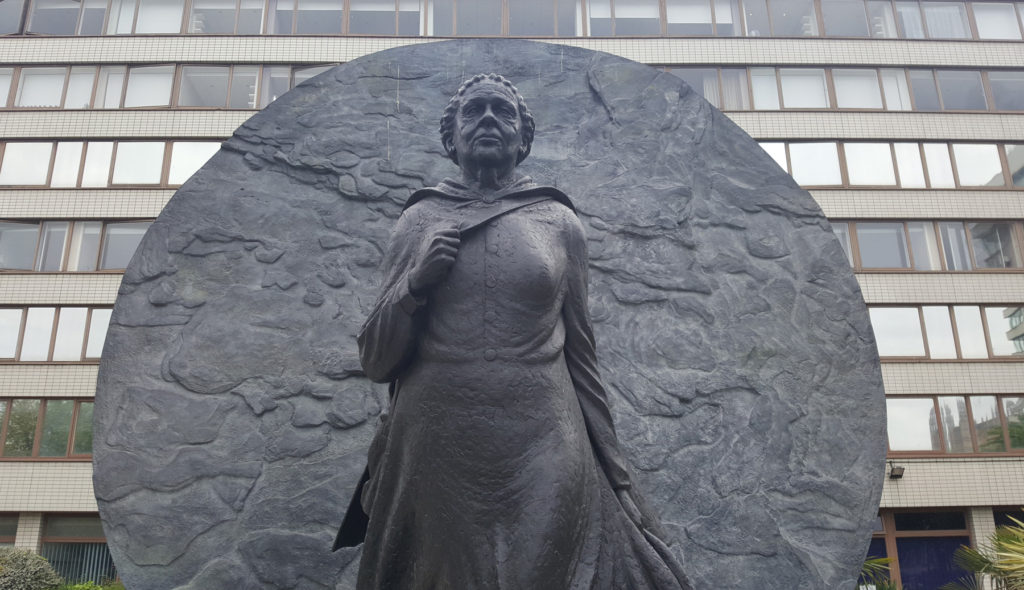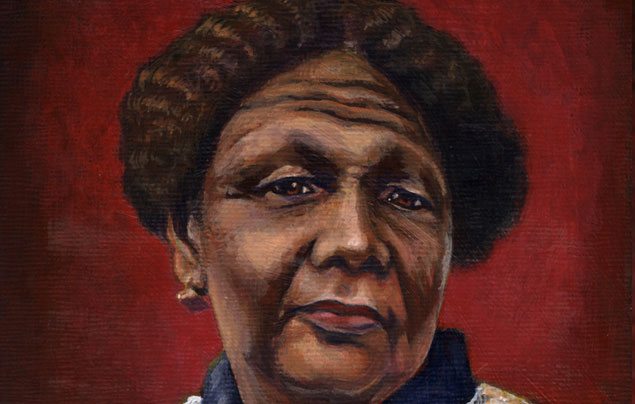In the pantheon of Jamaican heroic figures, the name Mary Seacole is rarely, if ever mentioned. True, there is a hall of residence for ladies on the Mona campus, Jamaica of the University of the West Indies named after her and the front entrance of the Institute of Jamaica is graced with a plaque in her honour as well as housing the replica of a terra cotta bust said to be sculpted by Queen Victoria’s nephew Count Gleichen. The Nurses Association of Jamaica (NAJ) memorializes her with a portrait on the outside wall of its Headquarters at 72 Arnold Road in Kingston and in 1963 acquired its own bust which rests in the foyer of its headquarters. Mary Seacole is remembered by the NAJ once a year when its members observe International Nurses Day alongside her nemesis that ‘other lady with the lamp’ Florence Nightingale. In 1991, Mary Seacole was awarded Jamaica’s third highest national honour, Order of Merit (0.M.) but otherwise remains on the fringes of Jamaican history.
Contrast that with the recognition given to Mary Seacole and the gratitude shown by her ‘second country’, Great Britain, beginning with the immediate years after the end of the Crimean War when she returned from nursing British soldiers at the battlefront, broke and penniless. Mary was not only feted with a 4-day fundraising gala attended by 80,000 persons, but was provided with a government pension for life. Since then, Britain has memorialized her by:
- Erecting a statue in her honour mounted on the grounds of St Thomas’ Hospital at Westminster, London. The statue looks towards the river Thames, facing the Parliament buildings. She is the first named black woman to be honoured with a statue.
- A blue identification plaque mounted on her home in London
- Having her portrait hung in the National Portrait Gallery
- Including Mary Seacole in the school curriculum ensuring that she is studied by every school child in Britain
- The Royal College of Nursing recognizing her contribution to British nursing by publicly declaring her to be on the same footing as Florence Nightingale.
In a 2004 poll Mary Seacole was voted the greatest Black Briton of all time.
Mary Seacole might have achieved fame and recognition ‘in foreign lands’ but she was Jamaican to the core and proud of her Jamaican heritage. Professor Verene Shepherd of the University of the West Indies points out that Mrs Seacole never at any time denied her black heritage. Referring to her haughty and proud portrait that hangs in the National Portrait Gallery, Helen Rappaport the leading researcher on the life and legacy of Mary Seacole, points to the red scarf she wears in the painting as signifying her pride in her Jamaican background. Mary Seacole’s skills as a healer were honed at the feet of her mixed-race Jamaican mother and her early experiences in tending to the ill and injured came from practicing at her mother’s lodging house and nursing home in Kingston.
According to Helen Rappaport:
“Mary’s skills and compassion as caregiver certainly define her in our modern-day terms as a nurse, but in fact in the Jamaican tradition from which she sprang, she was not a nurse but a physician cum pharmacist cum surgeon in the creole ‘eclectic’ herbal tradition”. (See: “The Creole Doctress of Jamaica” at https://helen rappaport.com/mary-seacole-black-victorian-history).

It must not be forgotten that born in 1805 when the majority of her countrymen and women still suffered under the yolk of slavery, Mary spent the first 45 years or the greatest portion of her life in Jamaica before starting out on her travels in 1851. Even after settling in England at the end of the Crimean war, Mary travelled regularly to Jamaica during the decade of the 1860s. It is against the background of what Britain has done to honour Mary Seacole that Jamaica’s efforts must be measured.
Mary Seacole Hall at the UWI is the one institution where the memory of Mary Seacole is not only sacred but is always present. As part of their initiation, all Seacolites learn about the proud legacy after whom their residence is named and the ladies who reside there are also constantly exposed to the qualities for which Mary Seacole was known and which they are expected to emulate as part of their character building experience.
Images from Mary Seacole Hall, University of the West Indies, Mona Campus
WHO IS MARY SEACOLE?
To the British, Mary Seacole is a Jamaican/British war hero who supported British troops as a nurse during the Crimean War (1853-1856) when England, in alliance with France, fought against Russian expansion into what is today’s Romania. That war was known for its ferocity and heavy casualties when more than 200,000 combatants were killed. On her own initiative and at her own expense, Mary Seacole travelled to the frontline and became the only nursing and rehabilitation facility at the scene of battle. She became so widely loved for her healing powers that soldiers nicknamed her ‘Mother Seacole’. She is credited with inspiring thousands of women and people of colour to dedicate their lives to Britain’s National Health Service (NHS). Mary Seacole’s story is told in her own words in her autobiographical work Wonderful Adventures of Mrs Seacole in Many Lands published in 1857. She was the first black woman to write and have an autobiography published. How can Jamaica make up for its relative neglect of one of its most brilliant daughters?

‘PUT MARY SEACOLE ON THE NEW £50 NOTE’
Jamaica and Jamaicans in the UK can begin to redress the balance of neglect by supporting and signing the online petition launched in 2018 by Jamaican-born activist, Patrick Vernon which has so far garnered over 135,000 signatures. The petition is part of a broader campaign dubbed the ‘Banknotes of Colour’ which is a joint initiative of social activist Zehra Zaidi and Vernon which aims to secure the first ever ethnic minority face on a British banknote – a new £50 note due to be released into circulation before the end of 2019. The campaign has, in recent times, gained the support of over 100 Members of the British Parliament who have crossed party lines to write to the Governor of the Bank of England Mark Carney, backing the call for ethnic diversity on the nation’s banknotes. Co-ordinated by MP Helen Grant, Vice Chair of the Conservative Party, the signatories to the letter call on the Governor “to urgently review and take action on the lack of representation of ethnic minorities on British banknotes”. Britain’s Daily Telegraph newspaper (February 18) reports that it is one of the few letters to get cross-party support on an issue of race equality and the role of one of the key institutions in Britain. The call has also been supported by the Secretary of the Exchequer (The Treasury) Robert Jenrick who has urged the Bank of England NOT to choose a white scientist for the new note as it risks sending a damaging message that ethnic minorities are invisible.
LETTER TO BANK OF ENGLAND BY MPS
It now appears that the campaign is having some effect as Bank of England Governor Carney has bowed to pressure and declared that a diversity candidate will be considered, highlighting the possibility of a pioneering scientist, Mary Seacole appearing on the note.
Selection of Mary Seacole for the face of the new bank note would be huge! For starters, she would be the first black woman to appear on a British banknote and one of only four women including the reigning Queen Elizabeth 11 to ever grace its paper currency. Timing would also be crucial because as Britain moves towards a cashless system, this new banknote could be the last occasion on which a new one is issued, making it the only remaining opportunity to have a black face on a currency note. Even if Mary Seacole is not the person selected, Britain would have paid her the ultimate honour by elevating her to the status of being considered a scientist, the main criterion for nomination. Much as she was revered by those who knew of her skills and exploits, Mary was never accepted as a scientist because of her lack of formal training. She was regarded more an entrepreneur, rather than for her contribution to science and medicine. Recognition by the Royal College of Nursing for her contribution to nursing and putting her on the same footing as Florence Nightingale has paved the way for her elevation in status.

Jamaica has bestowed the accolade of National Hero on six of its citizens, erected statues to honour folklorist Louise Bennett and reggae music icon Bob Marley as well as its athletes, and named highways and public buildings after retired politicians. In our efforts to memorialize our pioneers and role models Mary Seacole seems to have been forgotten. Jamaica will no doubt be quick to claim Mary Seacole’s heritage if the Bank of England decides to select her to be the face of its ethnic minority. The government and institutions like the Bank of Jamaica should unreservedly support Mary Seacole’s selection now – not when it is a fait accompli, but for once be bold enough to stand up and support its countrywoman.
What Jamaica should do to memorialize and honour Mary Seacole:
- As a nation, support the call for Mary Seacole to be the face of the new British £50 pound note.
- Rename the Kingston Public Hospital the Mary Seacole Hospital
- Erect a life-sized statue of Mrs Seacole to be visibly mounted at the KPH
- Declare an annual Mary Seacole Day when the medical profession, health training institutions and schools would engage in activities to commemorate Mary Seacole’s memory
- The National Library of Jamaica should collaborate with the Nurses Association of Jamaica to re – publish a special edition of Mary Seacole’s autobiography and seek the financial support of the CHASE Fund in facilitating distribution of copies to schools, libraries and other health training institutions. Further, the autobiography should be made required reading for all nursing students including those pursuing courses in practical nursing.
In selecting the Jamaican/British face of Mary Seacole for its new banknote, Britain has a glorious opportunity to show its citizens and the world at large that it truly values its ethnic minorities and accept the reality of its multi-racial society. No amount of “Windrush” atrocities can turn back the clock of its inglorious colonial past. Rather accepting Mrs Seacole as the symbol of its multi-ethnicity, will serve as an act of atonement and help it to regain some of its dignity and the trust of its citizens.
For more information on Mary Seacole’s Jamaican heritage visit the website of the National Library of Jamaica https://nlj.gov.jm/biographies/mary-seacole-1805-1881/







